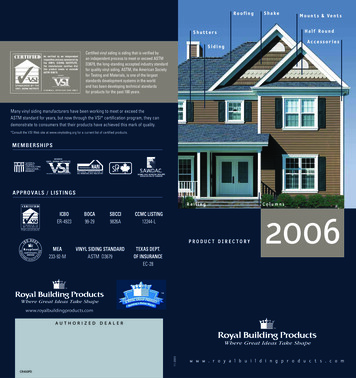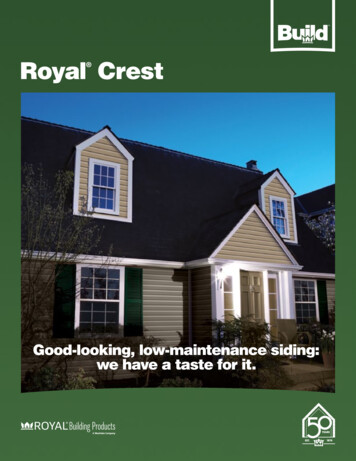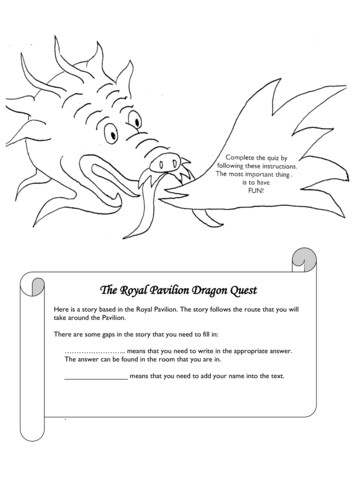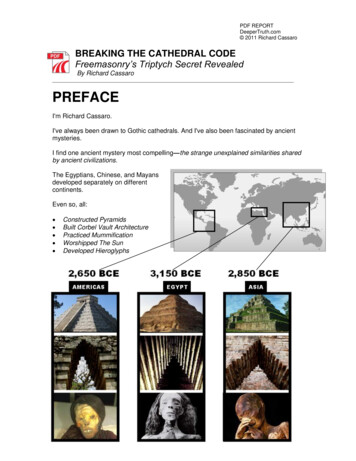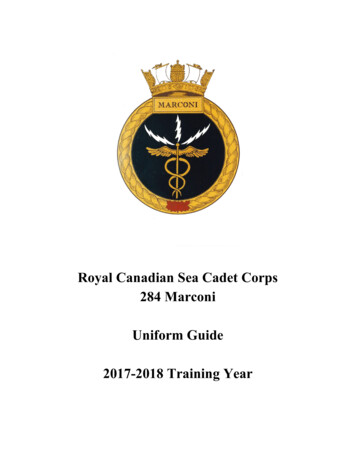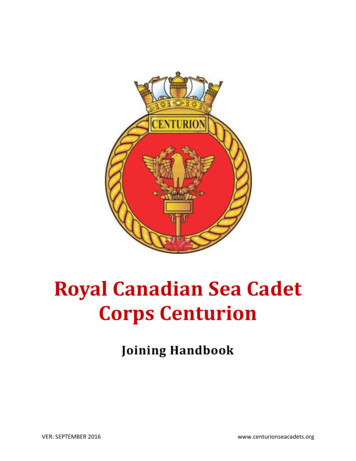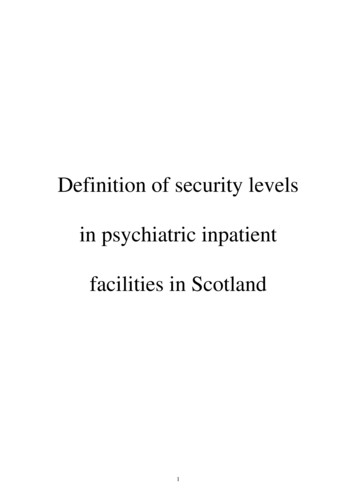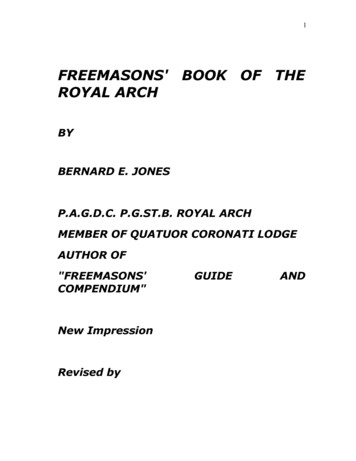
Transcription
1FREEMASONS' BOOK OF THEROYAL ARCHBYBERNARD E. JONESP.A.G.D.C. P.G.ST.B. ROYAL ARCHMEMBER OF QUATUOR CORONATI LODGEAUTHOR OF"FREEMASONS'COMPENDIUM"New ImpressionRevised byGUIDEAND
2HARRY CARR, P.A.G.D.C., P.G.ST.B.(R.A.)P.M. andLodgeSecretary,QuatuorCoronatiand Editor of its TransactionsandA. R. HEWITT, P.A.G.D.C., P.G.ST.B.(R.A.)P.M. andTreasurer, Quatuor Coronati LodgeLibrarian and Curator of Museum,United Grand Lodge of EnglandWith thirty-one plates in half- tone andmany line illustrations in the textGEORGE G. HARRAP & COMPANY LTD
3LONDON TORONTO WELLINGTON SYDNEY
4
5PREFACETHIS book, uniform in style and presentation with my earlierFreemasons' Guide and Compendium, which, in the main, dealtwith Craft masonry, is an attempt to provide a simpleexplanation of the origin, rise, and development, and thecustoms, ritual, and symbolism, of Royal Arch masonry so faras present knowledge and considerations of Masonic proprietypermit. I use the word ‘attempt' advisedly, for great difficultiesare in the way of complete achievement in writing historically ofthis "elusive degree," although, let me say, in the task of copingwith them I have been greatly cheered by recollections of theindulgence given me by readers of my earlier book.The greatest obstacle in the path of the writer seeking toexplain the early history of Royal Arch masonry is hiscomparative ignorance of the formative days of the Order - themid-eighteenth-century period. The facts on record are notenough to preclude different interpretations and conflictingviews. Perhaps it is a slight compensation that the traditionalhistory upon which the ceremonial of the Order is founded wasclearly anticipated in published writings to an extentconsiderably greater than in the case of the Craft, for whereas,for example, there is hardly any recorded foreknowledge of theThird Degree Hiramic story, the Legend of the Crypt might wellhave been inspired by one known to have been in written formin the fourth century of the Christian era, while thesword-and-trowel motif, derived from the Old Testamentaccount of the return of the Jews from exile, was the pride andglory of a Crusading Order of the early Middle Ages.
6What I have tried to do in writing this book is to make availableto Companions who have had little opportunity for specializedstudy an essentially readable account, as authentic as possible,of the history and lore of the Royal Arch, affording an insightinto some matters which in the past have tended to escape theattention of all but the serious student. Not only do I hope thatmy readers will enjoy reading my book, but that some few ofthem will be able to use it as a source of material for short,simple addresses designed to arouse and foster the interest oftheir Companions. And most sincerely, also, do I hope that theserious student will find in it occasion for kindly, constructivecriticism; indeed, I am8sure he will, for there are wide and unavoidable differences ofopinion on some of the subjects discussed by me.The title of this book may be thought to err by omission.Inasmuch as the Articles of Union, 1813, use the term ‘HolyRoyal Arch' and the early Companions knew the Order by thatname, it may be thought that the word ‘Holy' ought to beincluded in the title and commonly used in the text. True, thereis history in the word. ‘Holy' is thought to have been derivedmore than two centuries ago from the ‘Antient' masons' motto,"Holiness to the Lord"; or to have been inspired by the Holy ofHolies, the Inner Chamber of the Temple Sanctuary; or, again,to have reflected the religious, and even Christian, character ofthe primitive Royal Arch ceremonial. But it is to be noted that itis only sparingly used nowadays in the accepted rituals, and - afact that has mainly influenced me - it does not form part of thetitles of the Grand Chapters of England, Ireland, and Scotland.
7So great a part of our knowledge of Royal Arch matters havingbeen revealed by modern, and even quite recent, research, itfollows that oldtime writings on the subject need generally tobe read with caution. In no section of Masonic authorship hashistory been so badly served as in that of the Royal Arch, wherethe blending of fact and fancy so often causes the readerperplexity. I hope that my readers will do their best to approachthis book with minds open and as free as possible ofpreconceptions.In preparing myself for my task I have necessarily ranged overa wide variety of writings, and hope that I may fairly claim forthis book what my old friend the late J. Heron Lepper soappreciatively said of my earlier one-namely, that "it providesthe man who has small leisure for extensive reading with theessence and marrow of what has been accomplished in twogenerations of Masonic scholarship." The List of Contents andthe 16-page Index reveal at a glance the very wide scope of mybook.My qualifications as a Royal Arch mason may be briefly stated:I was exalted in the Savage Club Chapter, No. 2190, in 1913,and was in the First Principal's Chair in 1925-26. The writing ofMasonic books comes at the end of a long and active life spentlargely as an editor of technical books and periodicals. Aftermuch desultory Masonic reading and some modest lecturing Isettled down in 1945 to serious work preparatory to writing myFreemasons' Guide and Compendium, which was published in1950, since when I have applied myself more especially to thestudy of Royal Arch masonry, and of that study this book offersthe more particular fruit.
8Slight disparity between the opinions now expressed,particularly in the early sections of this book, and some in myother work may possibly9give occasion for comment. I confess that, with still widerreading and much further meditation, assisted by the results ofrecent research, I have come to regard the origin and rise ofRoyal Arch masonry in what I believe to be a truer perspective,allowing of my taking a more generous view of some of thequestions involved. But I am very far from pretending that I amable (or that anybody ever will be able) to offer anoncontroversial account of the early history of the Order.I am happy in acknowledging very considerable help extendedto me in the course of gathering material for this book, and it iswith gratitude that I mention especially one source ofinformation to which I am under a heavy obligation: the late J.Heron Lepper, Librarian and Curator (1943-52) of the UnitedGrand Lodge of England, a man of great gifts and considerableachievement, wide learning, and with profound knowledge ofMasonic history, built up over the course of years a mostunusual file of Royal Arch information (neither now nor thennormally available for reference), with possibly some idea that,given opportunity, he might one day turn it to account in theprinted word. Such a book, had he been spared to write it,would have been a classic, and mine would have remainedunwanted and unwritten. But his opportunity did not come, for,to the sorrow of us all, he died at Christmas 1952, at the age of
9seventy-four. By unique good fortune, to which my book owesvery much indeed, his successor, Ivor Grantham, courteouslyextended to me the privilege of working steadily through HeronLepper's file and of taking copies of any of its contents, and forthis great kindness-just one of a great many from the samehands - I shall ever be grateful.My debt to two other sources, Ars Quatuor Coronatorum (the"Transactions" of Quatuor Coronati Lodge, No. 2076, theworld's premier lodge of Masonic research) and MiscellaneaLatomorum (let us hope only temporarily suspended), is aheavy one, for there is little on my subject in the lengthy filesof these publications that I have not read in my search forenlightenment. All Masonic authors of to-day have reason to begrateful to these two remarkable founts of knowledge.To many of my fellow-members of the Quatuor Coronati Lodge(all of them authors of Masonic writings) I offer thanks formany marked kindnesses - as, for example, to John R.Dashwood (Secretary and Editor of the lodge "Transactions"),for many privileges, especially his help in connexion with thehistory of the First Grand Chapter and his kindness in findingand lending illustrations. (His publication, in the lodge"Transactions," of the actual record of the interrogation of JohnCoustos by the Inquisition (1743 and 1744) and of the minutesof the chapter that so quickly became the First Grand Chapter(1766), with his comments thereon, gives us two of the mostnotable recent contri-10
10butions to authentic Masonic history. I have well profited bythem.) Also, I would thank Harry Carr, for his painstakingrevision of the section on the Ineffable Name; George S.Draffen (Grand Librarian, Grand Lodge of Scotland), for placinghis manuscript The Triple Tau at my disposal in advance ofpublication and for permission to quote from it; Gilbert Y.Johnson, for help in connexion with the history of York RoyalArch masonry and for lending me his writings on the subject;Bruce W. Oliver, for his loan of an old MS. ritual, of which I havebeen able to make considerable use; Sydney Pope, forarranging for the photographing of an ancient banner preservedin the Canterbury Masonic Museum, of which he is Curator;Norman Rogers, for help in general and for the loan of his MS.on Royal Arch masonry in Lancashire; Fred L. Pick, forarranging for the loan of many photographs, some preserved inthe museum of which he is Curator and others belonging to theManchester Association of Masonic Research; John R. Rylands,for reading two early sections, the loan of his papers onYorkshire Royal Arch masonry, and permission to use hisphotographs of the Wakefield jewels; William Waples, for hismany notes on North-east Royal Arch masonry and forpermission to use two photographs; and Eric Ward, forproviding me with copies of minutes of old military chapters.Also, I wish to thank Ward K. St Clair, Chairman, Library andMuseum Committee, Grand Lodge of New York, U.S.A., for hiscourtesy and for permission to quote from his MS. paperrelating to the "Past Master Degree" in United Statesfreemasonry; Norman Hackney, for the use of photograph anddescription of an ancient Indian metal plate carrying significantsymbols; G. S. Shepherd-Jones, for the use I have made of hisexplanation of the symbolism of the Royal Arch jewel; C. F.Waddington, for his help in connexion with some of the Bristolceremonies; and the great many lodges and chapters whoserecords I have quoted and whose treasured possessions I have,
11in some cases, been able to illustrate, suitably acknowledgedwhere possible.I take particular pleasure in recording my great debt tomembers of the staff of the Library and Museum, Freemasons'Hall, London, who over a period of years have freely given meof their knowledge, and have allowed me, times out of number,to bother them in my search for information. To the Librarianand Curator, to whom I have already referred; the AssistantLibrarian, Edward Newton (who has suffered much of myimportunity); to H. P. Smith and T. Barlow, members of thestaff to all of them I offer my warm thanks for assistance in somany, many matters; to Henry F. D. Chilton, the AssistantCurator, I record my sincere appreciation of his help in choosingfrom among the Museum exhibits many of the diverse subjectsincluded in the thirty-one photographic plates with which thePublisher has so generously adorned this book. In thisconnexion I wish to thank the United Grand Lodge, theSupreme Grand Chapter, and also Quatuor Coronati Lodge fortheir loan of a great many of the illustrations, and the firstnamed for its particular kindness in taking the trouble on mybehalf of having photographs made of a number of its Libraryand Museum treasures.It will be understood, therefore, that it is with a lively sense ofthe help I myself have enjoyed that I now address myself toCompanions everywhere in the hope that my book, in adding,as I trust, to their knowledge of Royal Arch masonry, will servealso to add to the happiness and satisfaction which they derivefrom membership of the Order.B.E.J.BOLNEY
12SUSSEX
13PREFACE TO THE REVISED IMPRESSIONTWELVE years have passed since this monumental work on theRoyal Arch was first published, and in preparation for a newimpression opportunity has been taken to make a number ofimportant amendments in the light of modern studies in thisfield. The main changes occur in the sections dealing with theorganization of the ‘Antients' Royal Arch. Research has shownthat there never was an ‘Antients' Grand Chapter as such, sofrequently mentioned in the earlier impressions; its Royal Archactivities were controlled by the ‘Antients' Grand Lodge.Similarly, it was something of a misnomer to refer to the‘Moderns' Grand Chapter, which was, throughout its history, thepremier and the only Grand Chapter in England. The requisitemodifications have now been made, together with necessarycorrections in the section dealing with the Ineffable Name andminor corrections of dates, captions, spellings, etc., whereneeded. The general scheme of the original work, and thepagination, remain unchanged.H.C.A.R.H.JANUARY 196927 GREAT QUEEN STREETLONDON, W.C.2
14
15CONTENTSSECTIONPAGE1.ARCH?WHENCECAMETHEROYAL192. HOW CRAFT CONDITIONS PREPARED THE WAY FOR LARCHANDTHEROYALANDTHEROYAL
RYPTBIBLICALINEFFABLE
ONPRINCIPALSAND175THEIR16. AN EARLY QUALIFYING CEREMONY: PASSING THE YAL219
24.BANNERSTHEINTRODUCTORY226THETAU HY277CHARTER272OF
19INDEX279
20ILLUSTRATIONSPLATES IN HALF- TONEPAGEI. THE ROYALDERMOTTARCH AS DEPICTEDfrontispieceBYLAURENCEII. SWORD-AND-TROWEL EMBLEM, FROM GEOFFREYWHITNEY'S "CHOICE OF EMBLEMES," AND TRIPLEARCHESCERTIFICATESFROMROYALARCH32III. FRONTISPIECE OF SAMUEL LEE'S "ORBIS MIRACULUM,"OR "THE TEMPLE OF SOLOMON" (1659) ANDFRONTISPIECE TO "AHIMAN REZON" (1764),INCLUDING IN ITS UPPER PART THE ARMS OF THE
(1720-75)CHARTERNINTHLORD49OFBLAYNEYVI. TWO DECORATIVE APRONS OF THE LATE EIGHTEENTHCENTURY 64VII. THE KIRKWALL SCROLLGSVIII. THE DEVELOPMENT OF THE ROYAL ARCH EMBLEM ANDJEWEL80IX. ANCIENT METAL PLATE AND THE ALL-SEEING EYE INWROUGHT-IRONORNAMENT81X. THE CRYPT OF YORK MINSTER AND TWO TYPICAL
22SUMMONSES,CENTURYXI. ALARCHXII. TRACING-BOARD OF CHURCHILL LODGE, NO. 478,OXFORD, AND CEREMONIAL SWORD USED IN‘ANTIENTS' GRAND LODGE AND NOW BORNE INSUPREMECHAPTER112XIII.TWOAPPLIQUEXIV. BANNERCENTURYGRANDPAINTEDPAINTED IN128APRONSCOLOURSWORKED113LATEINEIGHTEENTHXV. COMBINED P.M. AND P.Z. JEWELS, LATE EIGHTEENTHCENTURY129XVI. CHARTER OF THE CANA CHAPTERS COLNE, NO. 116 AND
23BANNER OF ANCUMBERLANDOLDLODGE)144NO.2o8,ATWIGTON,XVIL TWO HANDSOME CHAIRS COMBINED CRAFT AND YOFTHE1790RUMMER,EARLYXX. PLATE JEWELS AND HEAVY CAST JEWELS, -1825192
24XXIII. A SET OF PRINCIPALS' ROBES) APRONS, AND HEADDRESSES193XXIV. TIONALXXVI. ED 00MASONICXXVIII. THE BELZONI AND OTHER RARE JEWELS ALL SET INBRILLIANTS240XXIX. A MINIATURE WCASTLEPASTAND256
RATIONS IN THE ATIONSCROSS233THETAUOFT-OVER-HANDTHETHETRIPLE233
26HOW THE PLAIN CROSS DEVELOPED INTO FORMS OF IANGLES238THE HEXALPHA SIX-POINTED STAR AND A FEW OF ITSVARIATIONS241A VARIETY OFMASONICPAGEINTERLACED TRIANGLESILLUSTRATIONFOUNDIN242MANY MASONIC DEVICES BUILT UP WITH AND WITHININTERTRIANGLESLACED243
27THE PENTALPHA (FIVE-POINTED STAR) IN SOME OF ITSVARIATIONS244A PIERCED JEWEL SHOWING TRIPLE ARCHES AND FIGURE OFSOJOURNER259A JEWEL OF THE THREE CROWNED STARS LODGE, PRAGUE259TWO SIDES OF OLD JEWEL OF UNCOMMON SHAPE ANDCROWDEDWITHEMBLEMS261A WELOFBOLDAND1812
28OBVERSE AND REVERSE OF THE ENGLISH ROYAL ARCHJEWEL264OBVERSE AND REVERSE OF THE SCOTTISH ROYAL ARCHJEWEL265OBVERSEJEWELOFTHEIRISHROYAL265ARCHA DESIGN (DATE 1630) BY THE FRENCH ENGRAVER CALLOT, APOSSIBLE PREFIGUREMENT OF THE ROYAL ARCH IGHTEENTHAN EARLY IRISH JEWEL CARRYING EMBLEMS OF D
29Section OneWHENCE CAME THE ROYAL ARCH?THERE has been long argument on how Royal Arch masonrycame into existence. Was it present in some slight form in theearliest fabric of speculative masonry or was it, frankly, just aninnovation in the first half of the eighteenth century? Thoseaccepting the first possibility believe that long before theearliest recorded dates of Craft masonry - the Acception in theLondon Company of Freemasons in 1621 and the ‘making' ofElias Ashmole in 1646 - there was a legend or a series oflegends from which was developed (a) the Hiramic Degreewhich was working in a few lodges certainly as early as the1720's; (b) the Royal Arch Degree known to be working by the1740's and 1750's; and (c) some additional degrees. All threewere thought to have come from one common source and,although developed on very different lines, to have runningthrough them a recognizable thread. Students of the calibre ofJ. E. S. Tuckett and Count Goblet d'Alviella were prominent inadvancing such a possibility. They felt that the legends relatingto Hiram and to the Royal Arch were the surviving portions of aCraft lore that originally contained other and similar legends,the Count holding that freemasonry sprang from "a fruitfulunion between the professional Guild of Medieval Masons and asecret group of philosophical adepts." The Guild furnished theform and the philosophers the spirit.Many students have thought that the Royal Arch was torn fromthe Hiramic Degree and that the 1813 Act of Union between the
30‘Antients' and the ‘Moderns’1 did scant justice in pronouncing"that pure Ancient Masonry consists of Three Degrees and nomore, namely those of the Entered Apprentice, the Fellow Craftand the Master Mason including the Supreme Order of the HolyRoyal Arch." We know that the Hiramic Degree was developinginto a practicable ritual in the years following 1717, in whichyear the Premier Grand Lodge was founded, and that the RoyalArch Degree was going through a similar experience two orthree decades later; this sequence in time is held to favour theidea that from the store of tradition came first the Hiramic storyof the First Temple and secondly the Sojourner story of theSecond Temple.1For explanation of these terms see the author'sFreemasons' Guide and Compendium, chapter 12.20Although Count Goblet d'Alviella suggests a union betweenmedieval masons and the philosophers, most students (thepresent writer among them) cannot see even a slight possibilitythat the Royal Arch has developed from operative masonry. TheCount probably had in mind the association between the slightspeculative masonry of the seventeenth century possiblycentred in the London Company of Freemasons and the learnedmystics practising Rosicrucian and alchemical arts. Many of thelearned men who came into masonry in those early days werescholars well acquainted with classical and medieval literature,who brought with them a curious and special knowledge and,so far as can be judged, grafted some of that knowledge uponthe short and simple ceremonies which then constitutedspeculative masonry. There is a good case for assuming that
31much of the symbolism of masonry was brought in by thosemystics, and there can be no doubt whatsoever that some ofthe best-known symbols of Royal Arch masonry bear a closeresemblance to those of alchemy; this point will be developedlater; for the moment we must accept the likelihood that RoyalArch masonry borrowed directly from the alchemical store ofsymbolism. But this or any similar statement does not implythat Craft and Royal Arch masonry came from one commonsource, for while, on the one hand, there are suggestions inBiblical and medieval literature on which a sort of HiramicDegree could be based and, on the other hand, traditions whichalmost certainly supplied the basis of the Royal Arch story, wedo not know of any traditions containing fundamentals commonto both-an ignorance on our part that is far from proof thatsuch a source never existed! With this slight introduction let usnow inquire more closely into the problems that arise.Did the Royal Arch develop from the Hiramic Degree?At times it has been strongly and widely held that the originalThird Degree of the Craft was ‘mutilated' to provide material forthe Royal Arch ceremonial. Dr Mackey, the well-knownAmerican writer, stated that, "until the year 1740, the essentialelement of the R.A. constituted a part of the Master's degreeand was, of course, its concluding portion." Both the Rev. A. F.A. Woodford and the Rev. Dr Oliver asserted that the Royal Archwas the second part of the Old Master's Degree; Dr Olivermaintained that "the difference between the ‘Antient' and the‘Modern' systems consisted solely in the mutilation of the ThirdDegree," and that "the R.A. was concocted by the ‘Antients' towiden the breach and make the line of distinction betweenthem and the Premier Grand Lodge broader and more
32indelible." It has been said that the 'Moderns, resenting tauntson their having transposed the words and signs of the First and21Second Degrees, were merely retaliating when they accusedthe ‘Antients' of mutilating the Third Degree.It so happens that the reverend gentlemen, A. F. A. Woodfordand George Oliver, are seldom reliable when dealing with anymatter relating to the great division in eighteenth-centurymasonry (a division which is explained in the author's earlierbook'). Both of them, forming their opinions somewhat lightly,wrote in a day lacking the new information which research hasbrought us in this matter. Dr Oliver professed to have a ThirdDegree ritual of 1740 in which some of the esoteric knowledgenow associated with the R.A. is mixed up with similarknowledge now associated with the Third Degree, but it isdoubtful if such a document exists. The modern student wouldrequire to see the document and give close attention to itsprovenance - that is, its origin and true date.W. Redfern Kelly believed that a Mason Word, recognized underthe ancient operative system and included in the First andSecond Degrees round about IM, was transferred to the ThirdDegree in the 1750's (apparently by the Premier Grand Lodge),and that later, perhaps about the year 1739, the Third Degreewas seriously mutilated to provide a fourth degree, it being aneasy matter, once again, to transfer both the Word and some ofthe legendary matter to the new creation. But, frankly, fewstudents nowadays accept these beliefs or look kindly upon the
33term ‘ mutilation' when used to describe the process by whichthe Third Degree is assumed to have yielded to the R.A. someof its choice content. To the present writer ‘mutilation' seems tobe quite beside the mark.Who is supposed to have been responsible for this process,whatever it was? The ‘Moderns' are alleged to have taunted the‘Antients' with being the offenders, but the suggestion isridiculous - and for the very good reason that the R.A. wasbeing worked as a separate degree before the ‘Antients' gotinto their stride! How could there be any obvious ‘mutilation' inview of the fact that the Craft ceremonies as worked by the‘Antients' more or less agreed with those worked by the Irishand Scottish masons? It is certain that the Irish and theScottish Grand Lodges, which were in the closest associationwith the ‘Antients,' did not mutilate the Third Degree to providea Royal Arch Degree, nor did they countenance others doing so,for, officially, they were just as hostile to the Royal Arch as the‘Moderns' were, and took a long, long time to modify theirattitude. At a particular date, it is known, says Hughan, thatthere was no essential difference between the first threedegrees in the French working and those in the English, proofthat no violent alterations had been made in the Third Degreefor the sake of an English Royal Arch rite. If the ‘Antients' didnot ‘mutilate' the Craft degrees it is inconceivable that the 'Freemasons' Guide and Compendium (Harrap, 1950).22‘Moderns' did so; it would be quite ridiculous to suggest thatofficially they ‘mutilated' a Craft degree to produce something
34which they then repudiated or treated with frigid indifference.This point will be returned to.No; it can be taken for granted that the most enlightenedstudents agree that there was no extraction from or transfer ofany large part of the Third Degree. There does not seem to beany evidence to support the statement that the Royal Arch wasoriginally a part of any Craft degree.A point of real importance is that the Hiramic Degree itself hadonly been more or less generally worked in England from sometime late in the 1720's, and that if the argument that it was‘mutilated' has anything in it we should have to believe that anewly worked degree was itself pulled to bits to provide anotherone. Douglas Knoop, a professional historian of marked ability,stated definitely that there is no evidence that our Third Degreelegend and our R.A. legend were ever combined in oneceremony.But let it be freely admitted that, while, on the availableevidence, there were no ‘mutilations,' it is likely - indeed,certain - that there were borrowings. We know, for example,that mention of any stone-turning in the Craft ritual of the1730's known to John Coustos (see p. 44) did not remain in theCraft working, but that the motif, amplified and drasticallydeveloped, does find a place in the R.A. working. CertainFrench tracingboards of the 1740’s depict ideas which are notnow in the Third Degree but are present in the R.A., buttracing-boards are seldom convincing evidence in such a matteras this, because in the early days Craft and Royal Archceremonies were worked in the same lodges, and inevitably anartist introduced into a tracing-board emblems from all the
35degrees known to him. Similarly, early jewels commonly depictboth Craft and Royal Arch emblems, but by the time suchjewels became popular the lines of the then early Royal Archceremony had been fairly well defined. These early jewels ofteninclude the emblems not only of the Craft and Royal Arch, butof one or two or more added degrees.A lodge that would be working Craft degrees on oneWednesday, let us say, and the Royal Arch the next Wednesday,in the same inn room and to a large extent with the sameBrethren present, would be likely, given time enough, to arriveat some admixture of detail; all the more likely would this be inthe absence of printed rituals and any close control fromsuperior authority. Given time enough, it is not difficult to seethat in such conditions a feature could pass from one degree toanother without causing much disturbance. This process ofborrowing, in a day in which communication was slow, mayhave led to some of the variation in working occurring betweenone district and another. Hughan thought that a particular testgiven in one of the sections of the Third Degree had found23its way into a prominent position in the Royal Arch Degree; the"test" he had in mind is apparently the Word, and thestatement is made that this word is still recognized in someMaster Masons' lodges on the Continent. Hughan's allusion isprobably to a Craft ritual given in an irregular print of the year1725: "Yet for all this I want the primitive Word. I answer itwas God in six terminations, to wit I am and Jehovah is theanswer to it." A telling argument against the suggestion thatthe Royal Arch was a ceremony largely taken from the Third
36Degree has already been referred to. It arises from thequestion: If such ‘mutilation' took place, how could the official‘Moderns' have denied the authenticity of the Royal Arch? Theywould obviously have known the treatment to which the ThirdDegree had been subjected; they would have been aware thata new ceremony had been made by partly unmaking anotherone, but they could hardly have questioned its essentials iforiginally these had been part of their own rite! Still moreobviously, how vastly different the Third Degree of the‘Moderns' would have been from that of the ‘Antients'! Weknow, of course, that there were detail differences betweenthem, but the two ceremonies were recognizably andessentially the same. Until proof is produced that the ‘Moderns'practised a Third Degree vastly different from that of the‘Antients' - a degree retaining cardinal features which the otherside knew only in the Royal Arch - until then we have no optionbut to conclude that the Third Degree certainly was not‘mutilated' to provide a separate degree.A strange version of the ‘mutilation' idea put forward by W.Redfern Kelly is that, to assist in bringing about the completereconciliation of the two rival bodies at the Craft Union of 1813,some section of the Third Degree may have been tr
Masonic books comes at the end of a long and active life spent largely as an editor of technical books and periodicals. After much desultory Masonic reading and some modest lecturing I settled down in 1945 to serious work preparatory to writing my
